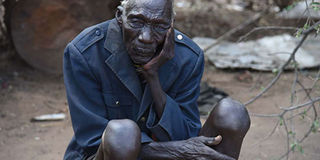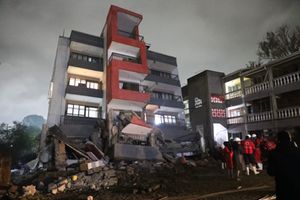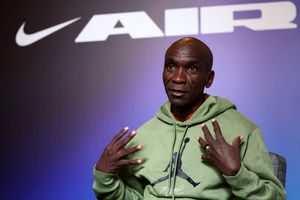Senior officials tackle policy issues but chief is the man on the ground

Akol Ekadeli of Nawountos village in Turkana County waits for food aid on March 19, 2019, as hunger bites. Chiefs were criticised by DP William Ruto for telling the media the harsh realities of the famine in their localities. PHOTO | FILE | NATION MEDIA GROUP
What you need to know:
- Chiefs in Turkana and Baringo, where famine is widespread, were in the firing line of no less a person than Deputy President William Ruto.
- Politics aside, it is important to objectively look at the history and value of the offices of the “Cabinet prefect” and that of the chief.
Two significant things have happened in the last two weeks, but as usual, they were eclipsed by politics. Early this week, the Treasury released figures indicating that the absorption of government funds has increased by nearly 200 per cent since the creation of a Cabinet committee to supervise and coordinate the implementation of State projects.
It is chaired by Interior CS Fred Matiang’i. Before its creation on January 22, average monthly absorption this financial year was about Sh 19 billion. This month it shot up to 52 billion. This is money that would have been lying idle at the Treasury, most of it likely to be stolen!
**
The week before, chiefs in Turkana and Baringo, where famine is widespread, were in the firing line of no less a person than Deputy President William Ruto. Their fault: they confirmed to the media that people in their locations had died of hunger.
CABINET PREFECT
It will be recalled that when the Matiang’i committee was formed, the DP’s supporter saw it as roadblock to his presidential ambition. But subsequent events have shown that the Matiang’i committee has little to do with succession politics.
Politics aside, it is important to objectively look at the history and value of the offices of the “Cabinet prefect” and that of the chief.
The two constitute the apex and the tail-end of the institution previously called the provincial administration, the institution we summarily loved to rake over the coals only because we judged it by its past baggage but ignored its salad aspects that have served us well.
Let’s start with the “Cabinet prefect”. From independence until the unveiling of the new Constitution in 2010, the office existed as the Head of the Civil and Secretary to the Cabinet.
CABINET MEETINGS
The holder was literally the Cabinet “prefect”. First, he chaired a committee of all permanent secretaries (PSs), which drew government policies, action plans, and saw to their implementation. Second, he or she drew up the agenda for discussion at Cabinet meetings, took notes, communicated them to the respective permanent secretaries, and saw to their implementation.
In the old constitutional order, Cabinet ministers were overrated figureheads. That is why President Moi could reshuffle them at will. He knew it made no difference to the working of the government since ministers were largely clueless busybodies elevated to serve a political purpose, and given the ego booster of flying the national flag on their vehicles.
If you doubt me, name one Cabinet minister from that era remembered for anything, apart from the late Tom Mboya, Mr Mwai Kibaki, and Mr John Michuki.
VACUUM
The new Constitution did away with the office of Head of the Civil Service and Secretary to the Cabinet, but left an office called Cabinet secretary, and which appears haunted. Its first holder was Mr Francis Kimemia, now Nyandarua Governor, and the last occupant of the earlier office of the head of the civil service.
But Mr Kimemia couldn’t be allowed to make impact because he didn’t belong.
It is an open secret that he was among the powerful forces in Kibaki government who weren’t enthusiastic about a UhuRuto presidency.
The next substantive appointee was Ms Monica Juma, now Foreign affairs CS, but whom Parliament declined to clear as required by the Constitution.
President Uhuru Kenyatta attempted to give the job to Mr Joseph Kinyua, but it did not work.
Next the President tried something called the Presidential Delivery Team but nobody seems to know what it is. Eventually he’d come up with the Matiang’i committee which, so far, seems to be getting its bearings.
TRAILBLAZERS
From independence until the enactment of the new Constitution, the Office of the Head of the Civil Service and Secretary to the cabinet had 11 occupants, who had mixed results.
In his new role, Dr Matiang’i might want to borrow from four of the 11. One is actually his mentor and father figure, Mr Simeon Nyachae.
The long-serving provincial commissioner came to the Cabinet first as permanent secretary for provincial administration and Cabinet coordination, an office specifically created for him by President Daniel arap Moi to prepare for him to be head of the civil service and secretary to the Cabinet, which was renamed office of the chief secretary.
Mr Nyachae was a forceful, hands-on man with a short fuse like Mr Matiang’i’s. He came up with the blueprint called District Focus for Rural Development, the closest the country came to a devolved system of government under the old constitution.
CHANGE
He also presided over the change to the 8-4-4 education system and instilled a measure of discipline in the civil service by dehorning public administrators who had carved “personal” fiefdoms for themselves.
Before Mr Nyachae, there was Mr Geoffrey Kareithi, who served the longest in the office, clocking 14 years. Self-effacing but highly efficient, he is acknowledged as the person who actually ran the government, especially in the last years of Mzee Jomo Kenyatta’s administration when age and failing health took a toll on the president.
After Mr Kareithi and Mr Nyachae, it took a decade for another performer to come around: Dr Richard Leakey.
In accepting the appointment, Mr. Leakey told the President that it would be on agreement that he be allowed to run the government, not as a bureaucracy, but as a business enterprise with eyes on delivery and profit.
AUTHORITY
The last of the four was Mr. Francis Muthaura, who served for eight of the 10 years of the Kibaki presidency. Like Mr Kareithi, he was quietly efficient and the one Mr Kibaki entrusted to run the show. Even in the “nusu-mkate” government when Mr Raila Odinga was prime minister and supposed Cabinet “prefect”, those in the know could tell where the real power rested.
As for the chief, ask any ordinary person who the closest authority they know is, and they will tell you it is the chief. The negative historical baggage is that the chief is a colonial relic. And the provincial administration was politicised to the point that “chief” became a dirty word.
But with the expansion in democratic space, today’s “chief” is likely a young, educated “digital” person. Besides enforcing law and order, it’s the chief who knows which homestead has a child who doesn’t go to school; the home where a patient has been detained in hospital for an unpaid bill, which projects are pending, etc.
HUNGER
And yes, Mr Deputy President, it is the chief best placed to tell who has died of hunger!
In an interview with this writer, Mr Kareithi recalled how much the late President trusted him to do his job that one day when he appeared at the airport to join the president in welcoming a visiting head of state, the president called him aside and whispered: “Geoffrey, I am not happy to see you here. You’re the one I trust to run my office. When you and I are here, it means there is nobody doing the job, which isn’t how it should be.”
He told me that when appointing his two last cabinets in 1969 and 1974, President Kenyatta requested him to draw a list of possible ministers, their assistants, and the PSs, and get back to discuss it with him. On both occasions, Mr. Kareithi told me, the President agreed his choices by up to 90 per cent, only replacing a few names.
a road whose construction began but was never completed, and the borehole whose CDF funding was





